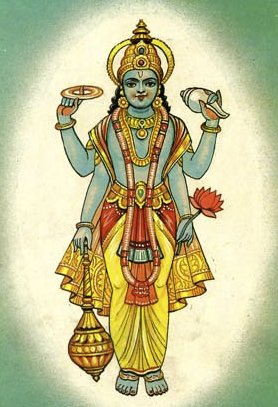Abhigamana: 12 definitions
Introduction:
Abhigamana means something in Hinduism, Sanskrit, Jainism, Prakrit. If you want to know the exact meaning, history, etymology or English translation of this term then check out the descriptions on this page. Add your comment or reference to a book if you want to contribute to this summary article.
In Hinduism
Vaishnavism (Vaishava dharma)
Source: Pure Bhakti: Arcana-dipika - 3rd EditionAbhigamana (अभिगमन) refers to “cleansing the temple of the deity” and represents one of the five limbs of Arcana (“deity worship”), according to the Arcana-dīpikā (manual on deity worship).—Abhigamana refers to cleansing the temple of the deity, anointing the deity with colours and sandalwood paste (candana), and at night removing the garlands, flowers and so forth that have been offered to the deity.
Generally, there are five limbs of Arcana [viz., abhigamana]. This is also known as pañcāṅga-viṣṇu-yajña (fivefold sacrifice performed for the pleasure of Śrī Viṣṇu). [...] These five limbs of Arcana (pañcāṅga-arcana) are not temporary and mundane but eternal, supremely pure limbs of bhakti that help one attain the lotus feet of Śrī Bhagavān.

Vaishnava (वैष्णव, vaiṣṇava) or vaishnavism (vaiṣṇavism) represents a tradition of Hinduism worshipping Vishnu as the supreme Lord. Similar to the Shaktism and Shaivism traditions, Vaishnavism also developed as an individual movement, famous for its exposition of the dashavatara (‘ten avatars of Vishnu’).
Languages of India and abroad
Sanskrit dictionary
Source: DDSA: The practical Sanskrit-English dictionaryAbhigamana (अभिगमन).—(a)
1) Approaching, going or coming to visit, arrival; तवार्हतो नाभिगमने तृप्तम् (tavārhato nābhigamane tṛptam) R.5.11,17.72; ज्येष्ठाभिगमनात्पूर्वं तेनाप्यनभिनन्दिता (jyeṣṭhābhigamanātpūrvaṃ tenāpyanabhinanditā) 12.35, K.158; Pañcatantra (Bombay) 3. (b) Finding out; enjoying; कृत्वा तासामभिगममपाम् (kṛtvā tāsāmabhigamamapām) Meghadūta 51. (sevanam Malli.).
2) Sexual intercourse (with a man or woman); परदाराभिगमनम् (paradārābhigamanam) K.17; प्रसह्य दास्यभिगमे (prasahya dāsyabhigame) Y.2. 291; Pañcatantra (Bombay) 1; वरं क्लैब्यं पुंसां न च परकलत्राभिगमनम् (varaṃ klaibyaṃ puṃsāṃ na ca parakalatrābhigamanam) H.1.116; नीच° (nīca°) Y.3.297,2.294.
Derivable forms: abhigamanam (अभिगमनम्).
See also (synonyms): abhigama.
Source: Cologne Digital Sanskrit Dictionaries: Shabda-Sagara Sanskrit-English DictionaryAbhigamana (अभिगमन).—n.
(-naṃ) Approaching, going near to. E. abhi, and gamana going.
Source: Cologne Digital Sanskrit Dictionaries: Benfey Sanskrit-English DictionaryAbhigamana (अभिगमन).—[abhi-gam + ana], n. 1. Approaching. 2. Mounting, [Kathāsaritsāgara, (ed. Brockhaus.)] 20, 154. 3. Sexual intercourse, [Pañcatantra] [prologue.] [distich] 8.
Source: Cologne Digital Sanskrit Dictionaries: Monier-Williams Sanskrit-English Dictionary1) Abhigamana (अभिगमन):—[=abhi-gamana] [from abhi-gam] n. = abhi-gama
2) [v.s. ...] the act of cleansing and smearing with cow-dung the way leading to the image of the deity (one of the five parts of the upāsana with the Rāmānujas), [Sarvadarśana-saṃgraha]
Source: Cologne Digital Sanskrit Dictionaries: Goldstücker Sanskrit-English DictionaryAbhigamana (अभिगमन):—[tatpurusha compound] n.
(-nam) 1) Coming near, approaching; e. g. Nyāya S.: ayasoyaskāntābhigamanavattadupasarpaṇam.— In the worship of the Vaiṣṇavas the word implies ‘adoration of the divinity, by cleansing the temples, images &c.’.
2) Sexual intercourse; e. g. Vivādach.: āryastryabhigamane liṅgoddhāraḥ; or Dāyabh.: putrārthaṃ prāthamikābhigamana eva śāstrārthaḥ . dvitīyādyabhigamanaṃ tu dṛṣṭaprayojanakamātrārtham; or Hitop. (ed. Seramp.): varaṃ garbhaśrāvo varamapi ca naivābhigamanaṃ varaṃ jātaḥ preto varamapi ca kanyāvajanitā . varaṃ bandhyā bhāryā varamapi ca garbheṣu vasatirna vāvidvānrūpadraviṇagaṇayukto pi tanayaḥ; comp. gamana and upagamana. E. gam with abhi, kṛt aff. lyuṭ.
Source: Cologne Digital Sanskrit Dictionaries: Yates Sanskrit-English DictionaryAbhigamana (अभिगमन):—[abhi-gamana] (naṃ) 1. n. Idem.
Source: DDSA: Paia-sadda-mahannavo; a comprehensive Prakrit Hindi dictionary (S)Abhigamana (अभिगमन) in the Sanskrit language is related to the Prakrit words: Abhigacchaṇayā, Abhigamaṇa.
[Sanskrit to German]
Sanskrit, also spelled संस्कृतम् (saṃskṛtam), is an ancient language of India commonly seen as the grandmother of the Indo-European language family (even English!). Closely allied with Prakrit and Pali, Sanskrit is more exhaustive in both grammar and terms and has the most extensive collection of literature in the world, greatly surpassing its sister-languages Greek and Latin.
Prakrit-English dictionary
Source: DDSA: Paia-sadda-mahannavo; a comprehensive Prakrit Hindi dictionaryAbhigamaṇa (अभिगमण) in the Prakrit language is related to the Sanskrit word: Abhigamana.
Prakrit is an ancient language closely associated with both Pali and Sanskrit. Jain literature is often composed in this language or sub-dialects, such as the Agamas and their commentaries which are written in Ardhamagadhi and Maharashtri Prakrit. The earliest extant texts can be dated to as early as the 4th century BCE although core portions might be older.
Kannada-English dictionary
Source: Alar: Kannada-English corpusAbhigamana (ಅಭಿಗಮನ):—
1) [noun] a going or flowing towards.
2) [noun] a going out to receive a guest coming in.
3) [noun] the act of sexual intercourse; coition.
Kannada is a Dravidian language (as opposed to the Indo-European language family) mainly spoken in the southwestern region of India.
See also (Relevant definitions)
Partial matches: Gamana, Abhi.
Starts with: Abhigamanadanda.
Ends with: Antyabhigamana, Gurutalpabhigamana, Naivabhigamana, Paradarabhigamana, Parakalatrabhigamana, Stryabhigamana.
Full-text: Stryabhigamana, Abhigacchanaya, Abhigamanadanda, Antyabhigamana, Parakalatrabhigamana, Paradara, Parakalatra, Upasana, Abhigama, Pancaratraraksha, Arcana.
Relevant text
Search found 7 books and stories containing Abhigamana, Abhi-gamana, Abhigamaṇa; (plurals include: Abhigamanas, gamanas, Abhigamaṇas). You can also click to the full overview containing English textual excerpts. Below are direct links for the most relevant articles:
Yoga-sutras (Ancient and Modern Interpretations) (by Makarand Gopal Newalkar)
Concept of Mokṣa according to Viśiṣṭādvaita Darśana < [Introduction]
Vastu-shastra (5): Temple Architecture (by D. N. Shukla)
Brahma Sutras (Shankaracharya) (by George Thibaut)
II, 2, 42 < [Second Adhyāya, Second Pāda]
The Padma Purana (by N.A. Deshpande)
Chapter 78 - Worship Prescribed for a Devotee of Viṣṇu < [Section 5 - Pātāla-Khaṇḍa (Section on the Nether World)]
Manusmriti with the Commentary of Medhatithi (by Ganganatha Jha)
Verse 2.189 < [Section XXX - Rules to be observed by the Religious Student]
Shakti and Shakta (by John Woodroffe)
Chapter XII - Alleged conflict of Śāstras < [Section 1 - Introductory]